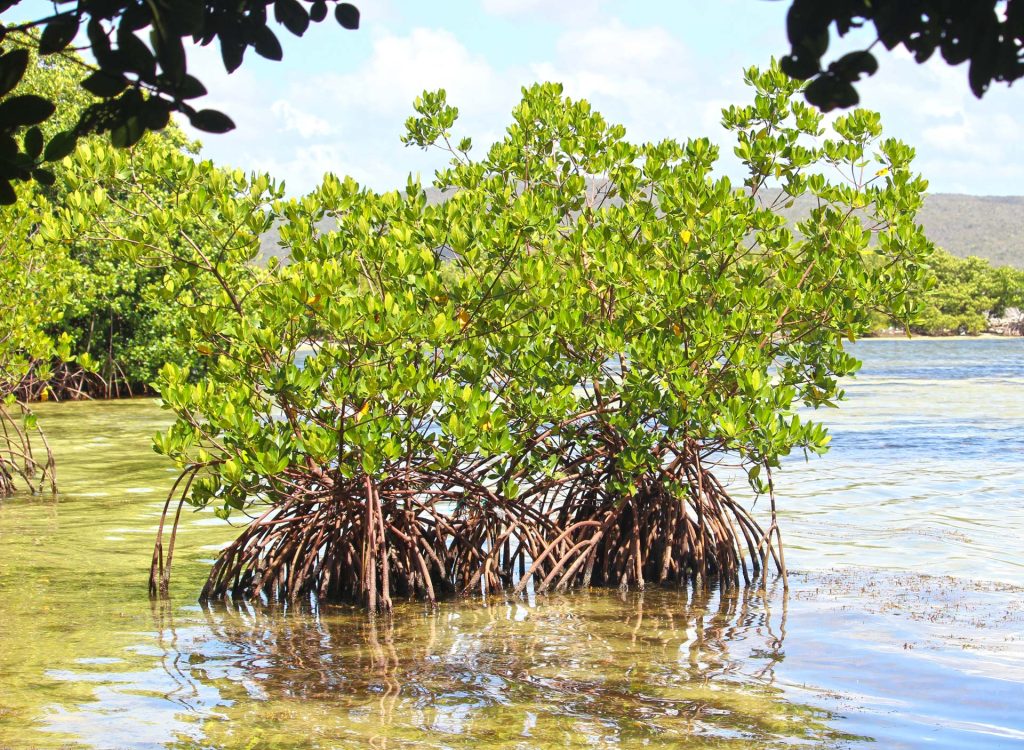When hurricane Ivan hit Jamaica in 2004, it killed 17 people and caused property damage and losses amounting to 8% of the island’s GDP. Not given as much attention was the storm’s destruction of large parts of the country’s natural environment.
Last July, organisers of a mangrove restoration project in Clarendon gave reporters a tour of coastal areas in the southern parish, including Portland Cottage and Peake Bay. Video and photos from the latter showed what looked like a greyish-brown, barren landscape, jagged tree stumps protruding from the ground — the kind of thing you might see in a dystopian sci-fi movie. It’s what’s left of a vibrant forest.
Years of human and environmental pressures left the Peake Bay mangroves vulnerable to Hurricane Ivan’s battering. In the years following, the area was further ravaged by hurricanes Dennis, Emily, Dean, and Sandy.
“This is a death of a thousand cuts,” Angeli Williams, project manager of SODECO — the University of the West Indies (UWI)’s Solutions for Developing Countries — told reporters.
SODECO is spearheading the restoration. “After years of different negative impacts on the mangrove, in 2004 — when we had Hurricane Ivan — the area could not recover after that,” Williams continued. “So for the last 20 years, what you’re seeing is a continuous die-off and degradation of this area until it ends up looking like this.” She waved her arm to show the devastation around her.
Jamaica has among the largest mangrove forest coverage in CARICOM (the Caribbean Community). Much of it is in the Clarendon parish on the island’s south coast, within the Portland Bight Protected Area — established in 1999 in part to preserve vulnerable flora and fauna, like sandpipers and other shorebirds.
Jamaica’s mangrove forests — consisting of trees that are adapted to salty water and grow along coasts — are also breeding and feeding grounds for the iconic and endangered hawksbill turtle and other animals, including 220 species of fish. Some of them, like mackerel and snapper, are important to the livelihoods of fisherfolk.
And there’s still a lot to be discovered about mangroves. In 2022, it was reported that scientists found the largest bacterium, Thiomargarita magnifica or “sulfur pearl” — the size of an eyelash — in the mangroves of Guadeloupe.
In an age of increasingly damaging effects from climate change, mangroves perform two key functions. They sequester harmful carbon dioxide from the atmosphere, holding it in the soil with their dense root system and in their biomass — the trunks, branches and leaves; and they provide protection from storm winds and flooding.
Both services are worth potentially hundreds of millions of dollars if Jamaica were to monetise the mangroves’ sequestered carbon through blue carbon credits, and because of reduced costs from loss and damage caused by hurricanes.
But of course the most important thing is that they keep people safe.
Ann Harvey, the owner of a preschool on Union Island in the Grenadines, told the BBC of her experience anxiously watching from home during Hurricane Ivan.
“I stood in a corner, just staring, concerned that the [school] roof would be blown away. But then I noticed something,” she said. “The mangroves were taking the brunt of the storm, protecting the school. For hours, they swayed in the wind and big waves crashed into them. Some of them eventually broke away, but nothing happened to the school.”
The mangroves that protected Harvey’s school were a small batch that remained from the forest at Ashton Lagoon that had been destroyed by a hotel construction project a decade before Ivan. The forest was restored in 2018 with the planting of more than 3,000 seedlings, and today is an attraction for tourists and locals alike.
Other successful restoration works in the region include the Ma Kôté mangrove forest along the southern coast of St Lucia — the largest mangrove forest in the eastern Caribbean. Parts of it were salvaged six years ago by planting around 4,000 trees with the involvement of more than 400 schoolchildren.
“The mangroves were taking the brunt of the storm, protecting the school. For hours, they swayed in the wind and big waves crashed into them. Some of them eventually broke away, but nothing happened to the school.”
Restoration of Bonefish Pond National Park in The Bahamas started in 2008 with the clearing of mounds of trash and other discarded debris, and is ongoing.
“Mangrove planting has become one of the most popular and trending conservation activities,” Elijah Sands of The Bahamas National Trust — caretakers of the park — writes in his blog, where he shows some of the more than 10,000 photos he took of tree-planting events over the years. “This means people are always reaching out wanting to plant mangroves.”
His favourite event, he writes, was the one where participants drank beer, planted trees, and kayaked to commemorate World Oceans Day 2021.
The Inter-American Development Bank, which provided funding for the Clarendon project, is also funding mangrove restoration in Suriname’s Bigi Pan Multiple Use Management Area — a protected area on the country’s northwest coast.
Jamaica started a series of restoration projects in 2008, largely under the guidance of Professor Mona Webber and the team she heads at UWI’s Centre for Marine Sciences. They have established two mangrove nurseries that can produce up to 20,000 seedlings. But often planting isn’t necessary, Webber explained in a TED Talk last year.
“In many cases, our approach simply requires removing blockages to water flow,” she said. “These blockages can include mounds of garbage compacted over many years in the forest, wood, downed trees from hurricanes, and marl — construction material! — dumped in the middle of a mangrove forest in order to reclaim land, usually for squatting.”
The Clarendon project is the most ambitious mangrove restoration project ever attempted in Jamaica, and possibly the English-speaking Caribbean. It aims to rehabilitate more than 1,600 hectares of mangrove. Webber pointed out in the TED Talk that the project, which she’s involved with as a consultant and a member of the steering committee, could increase Jamaica’s mangrove cover by nearly a third. “I’m really looking forward to this,” she added with a smile.
SODECO was founded in 2012 by medical scientist Professor Terrence Forrester, who that year had been honoured with the Order of Jamaica for his contribution to medical research. He had led the formation of UWI’s Caribbean Institute for Health Research.
SODECO’s current focus is on health problems related to poverty. “The environment and we people occupy a single indivisible ecological space,” Forrester explained via email. “Human health, wealth, and well-being unfold within this single ecosystem.”
He also explained the origins of the Clarendon project. “The hurricanes in 2004 and 2007 were the straw that broke the ecological camel’s back, and precipitated the mass die-off of mangroves along the Clarendon coast … We accepted the problem as something that had to be addressed, and set about tackling it by raising funds and acquiring expertise.”
An assessment of Peake Bay showed the channels that brought and removed sea and fresh water to the area are blocked.
SODECO plans to reopen the channels and introduce fresh water provided by mining company Jamalco. There’s no need for planting seedlings at Peake Bay, said Angeli Williams. They expect healthy trees on the edge of the dead area to propagate it once the hydrology is fixed.
“We’re aiming for natural regeneration,” she says. “We don’t have an endless budget so we have to act smarter.”
In Jackson Bay at Portland Cottage, they built a culvert across a roadway to restore the hydrology there. Baseline assessments and community consultations have been done in other areas as part of the decision-making on how to restore the other dead or dying forests.
The project will be a long-term endeavour. So it is with successful mangrove restoration. “We are not saying that the first move we make is going to be perfect,” said Williams. “But what we are saying is that we will do continuous monitoring so that we can adjust our interventions so that we can get the best possible outcome.”

